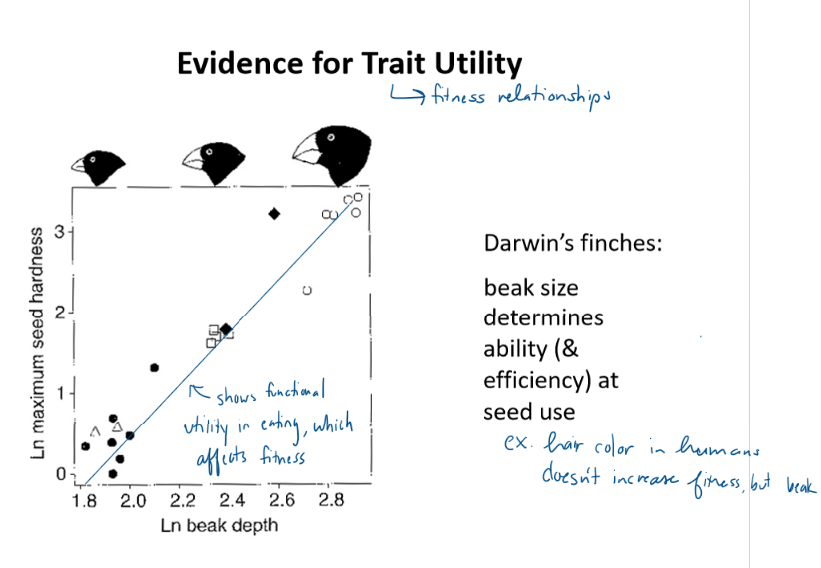Bio 263 FInal SG - everything combines
1/232
There's no tags or description
Looks like no tags are added yet.
Name | Mastery | Learn | Test | Matching | Spaced |
|---|
No study sessions yet.
233 Terms
How is a species defined?
An evolutionarily independent population(s)
What three concepts are used to identify species?
biological species
morphospecies
phylogenetic species
What is the biological species concept and how are species defined?
species defined based on reproductive isolation and lack of gene flow; do not interbreed or produce infertile offspring
Why is reproductive isolation important to the biological species concept?
Reproductive isolation prevents gene flow and allows speciation
What are 2 disadvantages of the biological species concept?
reproductive isolation can’t be determined in fossils or asexual species
can’t apply to populations that don’t overlap geographically ex. plants that can be bred together but are geographically isolated
What 2 mechanisms can prevent gene flow and cause reproductive isolation?
prezygotic/premating isolation - individuals prevented from mating
postmating isolation - individuals can mate but offspring sterile/low fitness
Describe the 5 types of prezygotic/premating isolation with examples
Temporal - ex. salmon that breed at different times of year
Habitat (physical isolation) ex. separated by mountains
Behavioral - ex. fireflies with specific flash sequences for identification
Genetic - ex. egg and sperm proteins are incompatible
Mechanical - ex. male and female parts don’t fit
What is prezygotic/premating isolation and what does it cause?
When individuals of different species are prevented from mating; stops gene flow, leading to speciation
What is postmating isolation and what does it cause?
when individuals of different species mate but egg/sperm can’t combine or offspring are sterile/low fitness
What is the morphospecies concept?
evolutionarily independent species are identified by differences in morphological features
What are disadvantages of the morphospecies concept?
can’t identify species that are morphologically similar but reproductively isolated through non-morphological traits
features used to distinguish species are subjective ex. wouldn’t usually consider sound differences as significant morphological feature
What are cryptic species and an example?
morphologically similar but reproductively isolated species ex. cricket species distinguished by chirp differences
What is the phylogenetic species concept
species defined based on monophyly using character changes; reliant on synapomorphies
What is a synapamorphy and why is useful?
shared, derived trait present in 2+ taxaon most recent common ancestor, but missing in more distant ancestors; helps infer evolutionary relationships
What is a character state and examples?
attribute of an organism ex. bone structure, nucleotide sequence
What is a monophyletic group?
group that includes an ancestral population and all of its descendants but no others
what is a paraphyletic group?
group that includes an ancestral population and some but not all of its descendants
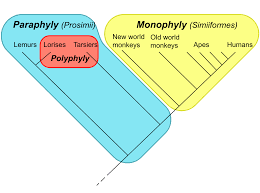
what is a polyphyletic group?
group that does not include the most recent common ancestors

what is a polytomy and what does it indicate?
node where an ancestral branch divides into 3+ branches; usually indicates insufficient data
What is homology?
similarity due to shared ancestory
what is homoplasy
similarity for reasons others than common ancestry (ex. convergent evolution)
What are 2 disadvantages of the phylogenetic species concept?
phylogenies only available for some populations
would increase number of recognized distinct species significantly
What is necessary for speciation to occur?
cutting off gene flow
What is speciation and how does it occur?
splitting of populations of a single species due to genetic isolation (stopped gene flow) and then divergence that maintains reproductive isolation
how does genetic isolation lead to speciation?
cuts off gene flow that is then maintained by divergence via selection, genetic drift, or mutation
What are the two types of speciation and their methods?
Allopatric speciation - geographic isolation by dispersal and vicariance
Sympatric Speciation - speciation in the same habitat by selection for something, mutations
What is Allopatric Speciation?
Geographic/reproductive isolation of a species by a physical barrier leading to speciation by dispersal or vicariance
What does “in allopatry” refer to?
population or species that is physically isolated from other similar groups by geographic barrier
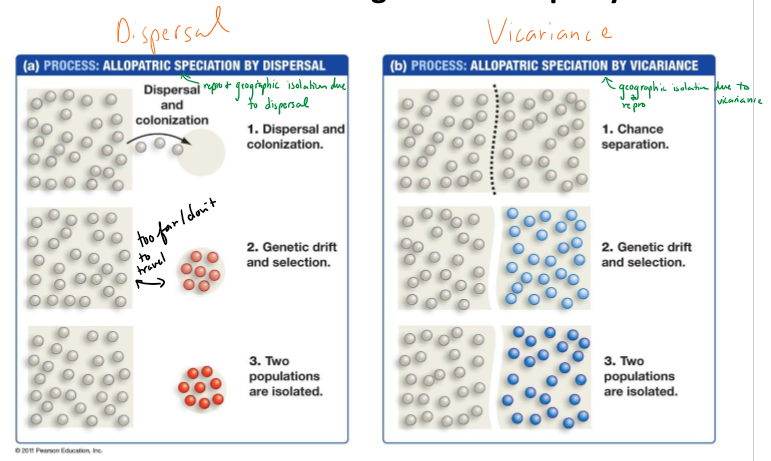
What is dispersal in allopatric speciation?
When a species colonizes a new habitat to form a new population, leading to genetic isolation and speciation
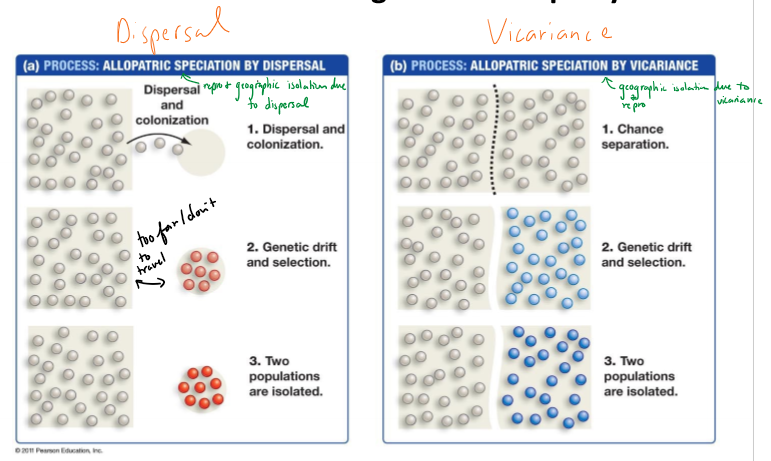
What is vicariance in allopatric speciation?
when a species is isolated from others in the population by a physical barrier, leading to genetic isolation and speciation ex. continental drift
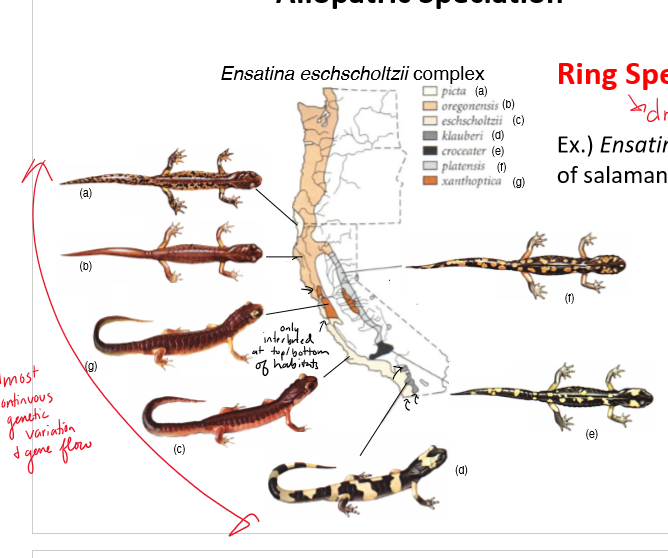
What are ring species?
connected series of neighboring populations, each of which interbreeds with closely sited related populations, but for which there are “end population” exist too distantly related to interbreed; forms an almost continuous ring of genetic variation and gene flow
What is sympatric speciation?
Speciation within the same habitat by mutation or selection for something (off disruptive selection)
What is polyploidy and how can it cause speciation?
3+ copies of a chromosome; can only breed with other polyploids or self
What can happen if isolated populations come into contact again?
if gene flow occurs, populations fuse
if prezygotic or postzygotic isolation has evolved, populations continue to diverge into separate species
reinforcement continuing speciation: strong natural selection for interbreeding traits that maintain isolation
What are hybrid zones?
Where interbreeding occurs and hybrids are common
What are the different ways that diversity is defined in a biological community?
species richness - number of different species in a community
species diversity index - species richness and evenness (ie. 1 of species 1, 10 of species 2)
What are the different types of pairwise species interactions and how are they defined?
commensalism - +/0 - one benefits, one neutral
mutualism - +/+ - both benefit
competition - -/- both lowered fitness
consumption - +/- - herbivory, parasitism, predation
What is a coevolutionary arms race?
adaptations and counteradaptations of dyadic interactions to stay ahead of competition/predators/prey
What is an ecological niche?
role a species plays in the environment, including resources used and conditions tolerated
how did the definition of a niche change from Joseph Grinnell to Charles Elton?
grinnell - niche was the sum of habitat requirements (emphasize abiootic)
elton - organisms place in the biotic environment, relating to food, competition, and predators
What is niche construction?
Modifying environment to boost own fitness/survival
What is an ecosystem engineer?
species that alter habitat ex. beavers
How does the ecological niche concept help explain community-level competitive
interactions between species, and why species coexist in some communities despite
competition, but cannot coexist in other cases?
two species can not possess the exact same niche
when completely overlapping species and a better predator (assymetric competition), weaker competitor can b elost
can exist in some communities when species can shift/specialize their niche
What is competitive exclusion and under what conditions does competitive exclusion occur?
no two species can have the exact same niche
occurs when competition is assymetric (different fitness effects due to competition) and niches overlap completely
What is a fundamental and realized niche? What results in species shifting between two niche states?
fundamental niche - niche without competition
realized niche - nice with competiton
caused by stronger competitor taking some of niche (like smaller seeds)
Under what conditions does niche differentiation and resource partitioning occur?
when species niches partially overlap
What is character displacement and when would it be expected to occur?
the evolutionary change in species’ traits
after change in resource use due to overlapping competition
How might the niche concept help explain the establishment of non-native species (or invasive species) in some communities?
invasive species can be a better competitor of a specific niche (can fully overlap another species niche and outcompete it)
when there is little competition in human modified area (ex. orchards, parks), invasive species can fill a large, no longer used niche
What is a keystone species? What role do they play in maintaining the diversity and structure of biological communities?
species that isn’t very abundant but has large effects and essentially supports the entire ecological community (ex. sea stars)
influence the abundance and distribution of other species; can prevent prey from becoming overly dominant ex. Sea otters in kelp forest ecosystems prey on sea urchins, preventing urchin overpopulation and the destruction of kelp beds
loss/reduction of keystone species results in decline in species diversity and community complexity
What is a foundational species?
species that have strong effects on their ecological communities and are numerous ex. bison
What role does disturbance play in shaping biological communities?
What is the sequence of community states that typically occur after a disturbance event, and how do the characteristics of species in those different community state differ?
remove biomass, alter resource availability and change community structure
pioneering community/species - high dispersal (ie. wind-dispersed seeds), tolerant, poor competitors, fast growing, often change environment and improve soil, weedy plants
early-successional - shrubs, short-lived trees, mix of pioneering plants and short lived trees
mid-successional - longer life span, more competitive, more stable ex. longer-lived trees
What is an ecosystem?
How do you define the difference between a biological community and an ecosystem?
ecosystem - abiotic and biotic interactions ex. energy flow, carbon cycle
biological - interactions between communities
What are biomes?
What conditions define different biomes, and how have they been classified?
large ecological areas w/ distinct cliamtes, vegetation, and biotic life
defined by temperature and precipitation, often latitutde
Describe the roles of spatial variation in energy flow to Earth’s surface and patterns of air circulation and rainfall in regards to the location of biomes
regions like rainforests have high net primary productivity due to high rainfall and tropical latitude, while deserts have low net primary productivity due to low rainfall and tropical latitude
high net primary productivity has lots of energy to move up the trophic structure
low net primary productivity has limited energy to move up to primary and secondary consumers
What is net primary productivity (NPP)? Why does NPP vary geographically around the Earth?
the rate at which photosynethtic organisms produce energy that can be invested in new tissues or offspring and eaten by other trophic levels
influenced by rainfall, sunlight, temperature
Describe the flow of energy transfer in a food web
primary producers are the basis of ecosystems and ~15% of energy is transferred up via food web/chain
examples of ecosystem ecology
biotic/abiotic factors
communities
nutritent cycling (water cycle, carbon cycle)
biogeochemistry
energy flow
hydrology
What largely determines biomes?
amount of rainfall and average temperaturs
What is net primary productivity?
the rate at which photosynthetic organisms produce new ‘useful’ energy that can be invested in new tissues or offspring
What areas have high and low net primary productivity and why?
high: rainforest — lots of rain and sun for plants
low: desert - not much rain aw
What is productivity?
biomass produced per unit of area each year
what is efficiency?
fraction of biomass transferred from one level to another; about 15% of energy transferredw
what is the basis of ecosystems and why?
photosynthetic producers
eaten and pass energy up
What is trophic structure and how are they connected?
energy flow
food webs are the connections between trophic levels
What are the types of Community Diversity and how are they defined?
Species Richness - the number of different species in a community
Species Diversity Index - number of species and evenness
What does species richness not account for?
Differences in species evenness
What are dyadic interactions?
2 species interacting with interspecific effects on fitness
What are the 4 types of dyadic interactions?
Commensalism +/0
Mutualism +/+
Competition -/-
Consumption +/-
What is commensalism and an example?
+/0
one benefits, no effect on other
fish hangs to grouper for scraps and protection, grouper does not care
What is mutualism and an example?
+/+
benefits both species, each pursuing own self interest
ex. nemo in anemone
When does competition occur and how does it affect the species?
occurs when resources are a limiting factor
negative fitness effects for both (symmetric or assymetric)
How do intraspecific and interspecific competition affect growth?
Cause density-dependent growth (carrying capacity, logistic)
What is consumption and the types?
+/-
one organism eats another
herbivory - plant tissue eaten
parasitism - host tissue eaten
predation - another individual eaten
How do dyadic interactions drive evolutionary change?
Fitness consequences lead to adaptations and counter adaptations
ex. shark eats a seal, remaining seals get faster and survive next time, shark evolves better smell
What are potential effects of dyadic interactions and the coevolutionary arms race?
fitness consequences
adaptations
changes in distribution and abundance
What is a niche?
The ecological role a species/population plays in an ecosystem, including resources and environmental conditions tolerated
What is niche construction and an example?
process where an organism alters its or another species environment to increase chances of survival
ex. diatoms releasing chemicals to make ground stickier
When can niches of species overlap?
During interspecific competition ( between species)
What is the competitive exclusion principle?
Impossible for species within the exact same niche to coexist; thus one species is competitively excluded when competition is asymmetric and niches overlap completely
When does a species become extinct in interspecies competition?
if asymmetric competition (weaker competitior)
completely overlapping niches
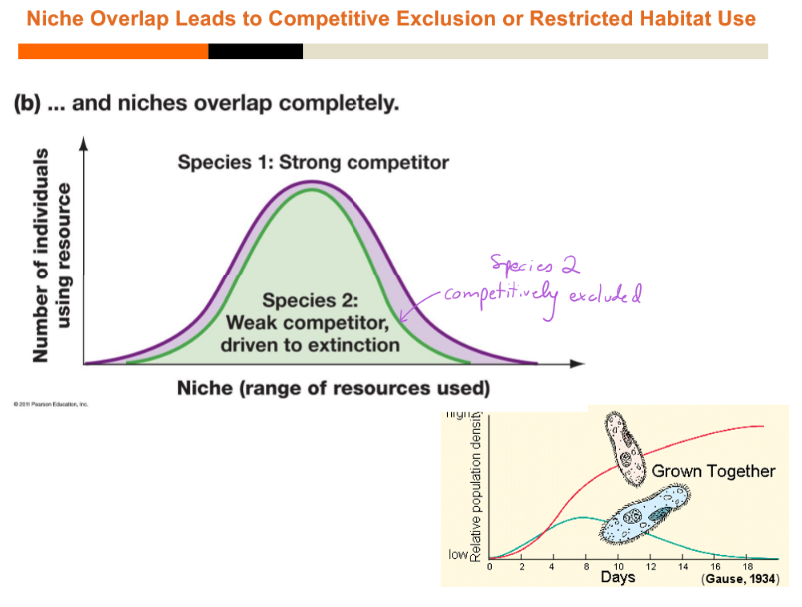
What is asymmetric vs symmetric competition?
asymmetric - 1 species suffers greater fitness decline
symmetric - equal decrease in fitness
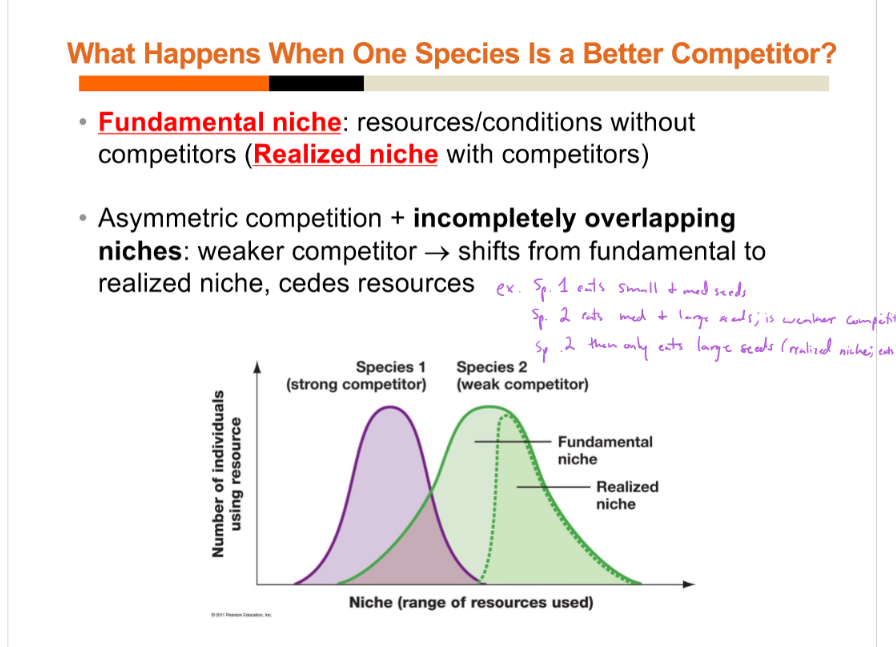
What is a fundamental and realized niche?
fundamental - resources/conditions used without competitors
realized - resources/conditions used with competitors
ex. species 1 eats small and med seeds (fundamental niche), stronger species 2 eats med and large, species 1 eventually eats only small seeds (realized niche)
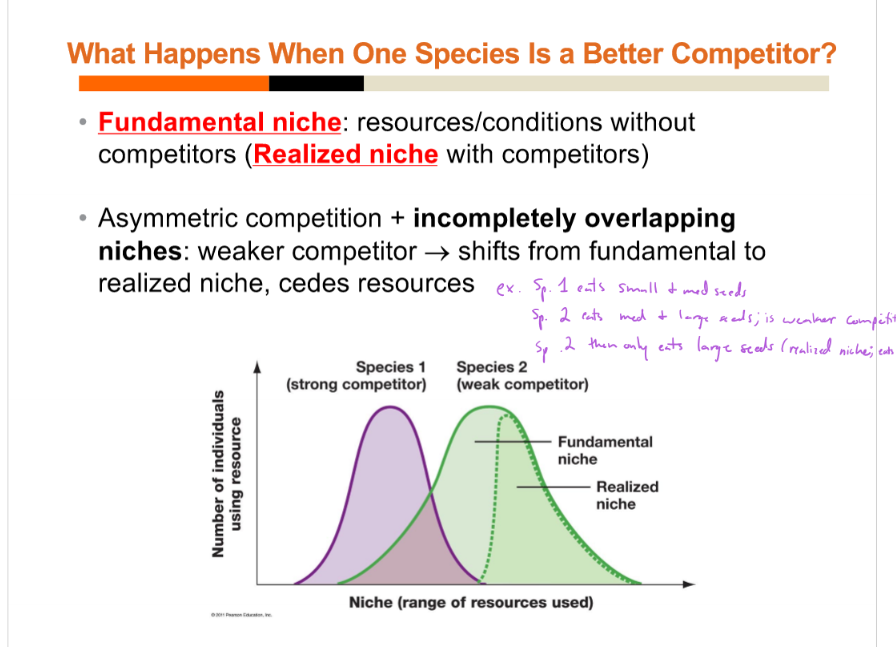
What does asymmetric competition and incompletely overlapping niches lead to for the weaker competitor?
Weaker competitor shifts from fundamental to realized niche, ceding resources
What are potential evolutionary consequences of species coexisting within partially overlapping niches?
niche differentiation
character displacement
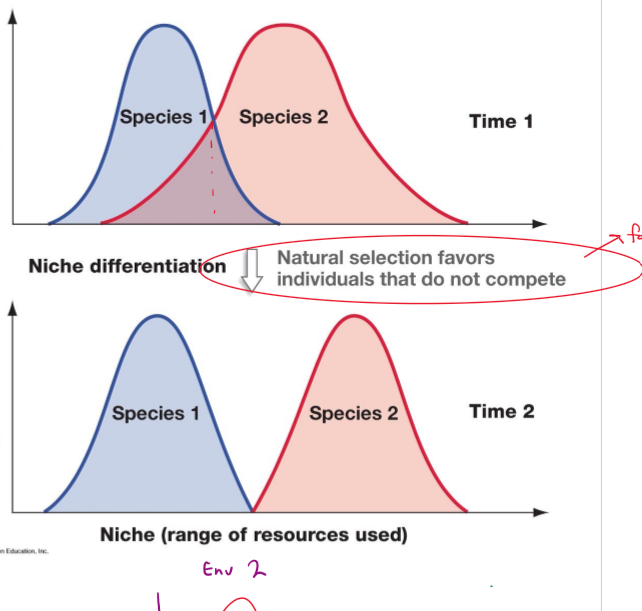
What is Niche Differentiation (or resource partitioning) and how do you know its occuring?
change in resource use due to overlap and competition with another species
natural selections favors reducing competition; species start to specialize in resources they don’t have to compete for
shown through realized niche and character displacement
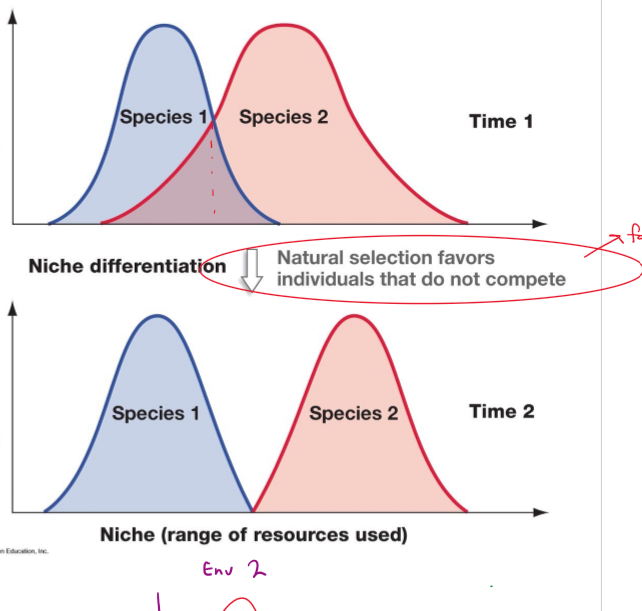
What is character displacement and when does it occur?
resulting evolutionary change in species’ traits
shifts in character away from species competing for same resource
occurs during competition for resources
Does evolution favor individuals that compete or don’t compete?
favors individuals that don’t compete; species may specialize to avoid competition
How does competition alter the course of evolution? What is an example?
competition changes fitness outcome
ex. big beaks favored for finches after first drought, small beaks favored after second drought when other larger beaked species are present
How does community diversity affect invasion?
Diverse communities more resistant to invasion
What is a keystone community and an example?
species that have disproportionately large effects on the structure of an ecological community relative to their abundance; support entire community
ex. low keystone otters —> high sea urchins —> low kelp —> species in kelp and that eat kelp die
How does the presence/absent of keystone predators affect species richness?
present: high diversity of other species in community
absent: low diversity of species in community
What does the reduction or loss of a keystone species trigger?
chain of reactions; decline in species diversity and community complexity; most susceptible to invasion
What is a foundational species and an example?
species that has strong interactive effects on community, largely bc of high population size
ex. bison, acorns
What is a disturbance and what can they cause?
natural disaster that removes biomass (fire, blizzard, drought, volcano, etc.); somewhat predictable/consistent
alters resource availability; changes community structure, can lead to predictable successional pathways after major disaster
What is a disturbance regime?
Type, frequency, severity of disturbances
What is a successional pathway and the steps?
specific sequence of species that arise in the rebuilding of communities after disturbance; trigger the next
pioneering species - high dispersal, tolerant, small/weedy, poor competitors; improve soil
early successional - medium dispersal, medium tolerance, medium size; ex. shrubs, short lived trees
mid successional - lower tolerance, larger, better competitors; ex. long lived trees
adaptative radiation
rapid diversification of a monophyletic ineage into several species, particularly due to exploiting environmental niches
What are the 4 parameters for detecting adaptative radiation?
common ancestry
phenotypes have adaptative values in the environment
fitness increase due to differing traits
rapid speciation
How do you show evidence for trait utility in adaptative radiation?
differing abilities correlate to a different fitness advantage
ex. different beak sizes more effective at different size seeds
